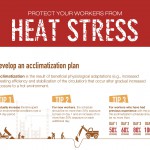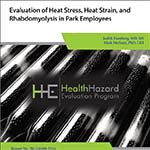Adjusting to Work in the Heat: Why Acclimatization Matters
Posted on by
Acclimatization is important in keeping your workforce safe and well as temperatures rise. This natural adaptation to the heat takes time, and from a management perspective, it may require careful planning.
Make acclimatization part of your plan
A good heat illness prevention plan takes into account the need for more breaks, a cool place to rest, the availability of fluids, and the careful allotment of time for a worker to become fully adjusted or acclimatized to the heat. It will need to be flexible based on the intensity of the heat, the level of humidity, the workers’ experience on the job, and the workers’ physical fitness.
Time to adapt
- New workers on an 8-hour shift should spend only about an hour and a half in the heat on their first day. Their exposure time should increase slowly—no more than a 20% increase per day.
- Experienced workers on an 8-hour shift can spend up to 4 hours in the heat on the first hot day. The next day they can likely manage 5 hours in the heat and about 6.5 hours third day. By the fourth day, most healthy workers should be able to tolerate 8 hours in the heat assuming they are well-hydrated and have appropriate rest breaks throughout their shift.
Fluids
 See our recently-published health hazard evaluation on extreme heat in a national park in California.
See our recently-published health hazard evaluation on extreme heat in a national park in California.Fluids are necessary to acclimatization. In fact, failure to replace the water lost in sweat will slow or even prevent the development of the physiologic adaptations to heat. Workers need to drink small amounts of water throughout the day so that they never become thirsty. For moderately intense work in moderate heat, this equates to approximately 1 cup every 15 to 20 minutes. Supervisors should encourage and remind workers to take water breaks. In some cases, when workers are experiencing heavy sweating, drinks containing electrolytes might be warranted.
Rest
In the heat, workers need more rest than they would in cooler environments. Provide a cooler place out of the direct sunlight where they can take their scheduled breaks. A shaded or air-conditioned rest area would be best. Air conditioning will not affect acclimatization. Remind and encourage workers that they need to take advantage of these rest breaks.
How does the body adapt?
When workers are initially exposed to hot work environments, they may readily show signs of distress and discomfort. Their core temperatures and heart rates increase. They may experience headaches, nausea, and other symptoms of heat-related illness. The brain’s thermoregulator detects the increases in skin, muscle, and organ temperature and ignites the body’s cooling mechanisms—primarily sweating and vasodilation of the skin’s blood vessels. As the body is exposed to the heat and is given proper recovery time, it begins to adapt. Total sweat production increases, and sweating begins at a lower skin temperature.
How should workers maintain these benefits?
A few days out of the heat won’t ruin a worker’s acclimatization, but absence from work in the heat for a week or more can result in a significant loss of those helpful adaptations. Upon return, the worker may combat acute dehydration, illness, or fatigue so supervisors need to make adjustments so the worker has time to re-acclimatize. This can take 2 to 3 days when returning to a hot job.
Planning for the heat requires extra care and effort. But a good heat illness prevention plan that allows workers to properly acclimatize, will reduce the risk of heat-related illness and death. For more information, visit the NIOSH Topic Page on Heat Stress.
Brenda Jacklitsch, MS
Ms. Jacklitsch is a health scientist with the NIOSH Education and Information Division.
Posted on by

